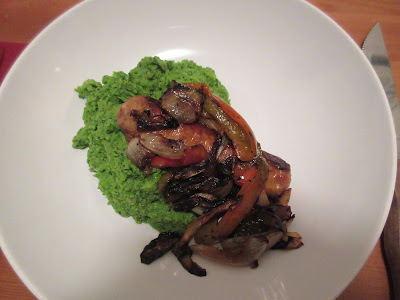Meal Plan (Subject to Rearrangement):
BreakfastLunch Dinner Friday
Sausage, Pea Puree, Peppers & Onions Saturday Waffles & Eggs Broccoli Soup Pasta, Sausage, & Roasted Red Peppers Sunday Toast & Eggs Soup/Pasta Black Beans (“poor man's feijoada") Monday Oatmeal Black Beans Fried Rice with Egg Tuesday Toast & Eggs Beans/Soup/Rice Dal with Flatbread & Raita Wednesday Oatmeal Dal Tofu & Butternut Squash Thursday Toast & Eggs Potatoes & Veg Sardine Pasta Friday Toast & Eggs Sardine Pasta
 |
| First Meal: Friday night, we dress for dinner after the first gong (Dan caught running by the camera timer). |
 |
| A closer look at the first meal--the sausage is hiding under all those sautéed peppers & onions! |
 |
| Second meal: breakfast, including extra-budgetary condiments (allowed under Challenge rules). There is an apple for Dan (budgeted), because I insist on eating fruit with breakfast every morning. |
 |
| Jasmine loves herself a breakfast sandwich! |
I am very skeptical about coupons. Every website that discusses either how to approach this challenge specifically or how to approach budget cooking in general insists upon the use of coupons, but I find that I never, or very rarely, encounter coupons. The main source of coupons as I understand them is Sunday newspapers, and I found mine in my parents’ Sunday newspaper when I was visiting them last week. If a newspaper costs several dollars (The New York Times is $6 in Hamilton, for example) and all you can find in it that you could possibly justify buying on a food stamp budget is turkey sausage, then for that 75 cent coupon you are at a $5.25 loss. If they were full of coupons like $1 off fresh broccoli or 50 cents off plain rice, they might be worth seeking out. But coupons do not encourage people to buy necessary products, but rather the ones manufacturers will make the most money from—coupons are marketing tools, and thus they often work only for new products that are excessively pigeonholed and ultimately silly, like spray margarine made from olive oil, or the newest, strangest line of wasteful cleaning apparati from Swiffer, which are only intended to be sold temporarily to give Procter & Gamble stock what Mitt Romney might call a "sugar high."
Back to meat. I have long felt that cured pork products like salami, bacon, prosciutto, pepperoni and the like are wonderful tools in a low-meat diet, because they go a long way. They are also fraught with carcinogens from a chemical reaction between the meat itself and the nitrites added to preserve the color (and don’t fall for the ingredient “celery extract.” It’s full of nitrites and the result is the same. Find more depressing information about so-called “clean labels” here). Still, eating less meat is probably more important for good health and curbing your consumption of the various (carbon, water, land, human and animal rights) excesses the meat industry is so guilty of than eating plenty of the best meat. And for goodness sake cured meats are delicious. But canned fish is an often-overlooked runner-up: anchovies are famous for their inordinate amount of flavor, but canned sardines and mackerel have a wonderful, rich umami taste and they’re bigger and meatier, cheap as can be, and lousy with healthy fats. Canned salmon and tuna are also great and when you use them as a topping or mixed with other things (like salmon burgers that are half sautéed vegetables or tuna-potato or tuna-white bean salad) they seem to stretch endlessly across servings. It’s important to say, because no one does, that these fish all come with bones that you should ignore, as they’re terrific for you and totally unnoticeable; in fact they disintegrate if you try to remove them anyway. Paying twice as much for boneless canned fish is a waste. We’ll have pasta with sardines this week, and it’s a truly splendid, rich dish you should try if you never have. And splurge for dill if you can.
All this is circumlocution around a point that I had better say plainly: the only way to eat meat that is remotely sustainable on this budget is to eat extremely little of it and to be willing to eat meats of little esteem. To that point, it is also not possible to eat much organic food on this budget except, as with sustainable meat, if you just have very little of it. And that means that, as with so many things, there is a double standard for the poor concerning high-quality food. Although there is nothing to say that either bearing the responsibility of consuming sustainable food or reaping the health benefits of that food ought to be the exclusive purview of the rich, these consumption choices effectively are non-existent for anyone who needs help paying for food: eat the cheapest food, however it’s raised or made, and be pretty hungry, or buy a very little food of higher quality and suffer dangerous hunger.
No comments:
Post a Comment